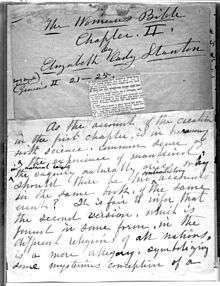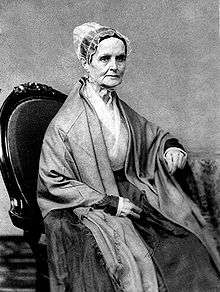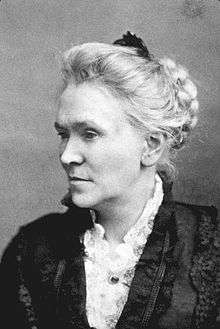The Woman's Bible
 Handwritten draft of commentary covering the Book of Genesis, Chapter II, verses 21–25, concerning Adam and Eve | |
| Author | Elizabeth Cady Stanton |
|---|---|
| Country | United States |
| Language | English |
| ISBN | 040504481X |
| OCLC | 363551 |
The Woman's Bible is a two-part non-fiction book, written by Elizabeth Cady Stanton and a committee of 26 women, published in 1895 and 1898 to challenge the traditional position of religious orthodoxy that woman should be subservient to man.[1] By producing the book, Stanton wished to promote a radical liberating theology, one that stressed self-development.[2] The book attracted a great deal of controversy and antagonism at its introduction.[3]
Many women's rights activists who worked with Stanton were opposed to the publication of The Woman's Bible; they felt it would harm the drive for women's suffrage. Although it was never accepted by Bible scholars as a major work, it became a popular best-seller, much to the dismay of suffragists who worked alongside Stanton within the National American Woman Suffrage Association (NAWSA).[2] Susan B. Anthony tried to calm the younger suffragists, but they issued a formal denunciation of the book, and worked to distance the suffrage movement from Stanton's broader scope which included attacks on traditional religion.[2] Because of the widespread negative reaction, including suffragists who had been close to her, publication of the book effectively ended Stanton's influence in the suffrage movement.[4]
Background

In the early 19th century advocates of women's rights began to accumulate rebuttals to arguments used against them founded on traditional interpretations of Bible scriptures. Lucretia Mott countered those who would put her in her place by quoting other Bible passages, or by challenging the original interpretation of the scripture. In 1849, Mott wrote Discourse on Woman which discussed Adam and Eve, the activities of various women who appear in the Bible, and argued that the Bible supported woman's right to speak aloud her spiritual beliefs.[5] Independently from Mott, Lucy Stone determined for herself that the male-dominant interpretations of the Bible must be faulty—she worked to learn Greek and Hebrew and thereby gain insight into the earlier Bible translations which she believed would contain wording more favorable to women's equality.[6] In New York, aided by Mott, Elizabeth Cady Stanton helped draft the Declaration of Sentiments in 1848 and included two Resolutions which protested against man's usurpation of rights relating to her position in church and to her role under God. By the 1850s, Mott had become expert at disarming men who used Scripture against her. At the National Women's Rights Convention in 1852, and again in 1854, she stood up to debate men who came prepared with Scripture in hand. Reverend Henry Grew told the 1854 convention audience that the Bible proved men were naturally superior to women. He was countered point-by-point by Hannah Tracy Cutler, then in broad societal and political terms by Mott who began by saying: "It is not Christianity, but priestcraft that has subjected woman as we find her. The Church and State have been united, and it is well for us to see it so."[7]
Revising Committee

In 1881, 1885 and 1894, the Church of England published a Revised Version of the Bible, the first new English version in over two centuries. Stanton was dissatisfied with the Revised Version's failure to include recent scholarship from Bible expert Julia Smith. She wrote:
Whatever the Bible may be made to do in Hebrew or Greek, in plain English it does not exalt and dignify woman. My standpoint for criticism is the revised edition of 1888. I will so far honor the revising committee of wise men who have given us the best exegesis they can according to their ability, although Disraeli said the last one before he died, contained 150,000 blunders in the Hebrew, and 7,000 in the Greek.[1]
Stanton assembled a "Revising Committee" to draft commentary on the new Bible version. Many of those she approached in person and by letter refused to take part, especially scholars who would be risking their professional reputations. Some 26 people agreed to help. Sharing Stanton's determination, the committee wished to correct biblical interpretation which they viewed as being biased against women, and to bring attention to the small fraction of the Bible which discussed women.[8] They intended to demonstrate that it was not divine will that humiliated women, but human desire for domination.[9] The committee was made up of women who were not Bible scholars, but who were interested in biblical interpretation and were active in women's rights.[8] Among the notable members of the international committee were Augusta Jane Chapin, Lillie Devereux Blake, Matilda Joslyn Gage, Olympia Brown, Alexandra Gripenberg, Ursula Mellor Bright, Phebe Ann Coffin Hanaford, Clara Bewick Colby, and Irma von Troll-Borostyáni.
In 1890 at the formation of the National American Woman Suffrage Association (NAWSA), Stanton was elected president. She left such duties to Susan B. Anthony and instead traveled to Europe for two years. While there she met with women who shared her views, and she gathered critical observations about the place of woman in the Bible. In Greenbank, Bristol, Stanton met with English suffragist Helen Bright Clark, and spoke to a group about the Bible position of woman. Clark questioned whether Stanton's liberal views had shocked some in attendance, and Stanton replied: "Well, if we who do see the absurdities of the old superstitions never unveil them to others, how is the world to make any progress in the theologies? I am in the sunset of life, and I feel it to be my special mission to tell people what they are not prepared to hear ..."[10]

In 1893, Matilda Joslyn Gage took time out from her participation in the Revising Committee to write Woman, Church and State, a book which challenged traditional Judeo-Christian teaching that women were the source of sin, and that sex was sinful. Gage wrote that the double standard for morality hurt both sexes.[11] Gage differed from most of the women on the Revising Committee in that she did not feel that the Bible, once interpreted in a more true, original form, would support women's rights. Gage determined that the Church had acted against women's interests in important ways: from Roman Catholic canon law, to Scripture, to its advocacy of celibacy and more. Especially troubling to Gage was the story of Adam and Eve.[6]
On August 1, 1895, the first part of The Woman's Bible was published, covering the Pentateuch (the first five books of the Bible): Genesis, Exodus, Leviticus, Numbers, and Deuteronomy.[12] The text went through seven printings in six months; it was a best-seller.[4] In January 1898, the second part was published, covering the rest of the Old Testament as well as all of the New Testament.[13] It included a Preface written by Stanton in which she acknowledged that "Both friend and foe object to the title."[14] Nevertheless, she praised the Revising Committee for showing "a more worshipful reverence for the great Spirit of All Good than does the Church."[14] Stanton wrote: "We have made a fetich [sic] of the Bible long enough. The time has come to read it as we do all other books, accepting the good and rejecting the evil it teaches."[14]
Reaction
At its introduction, The Woman's Bible was widely criticized in editorials and from the pulpit. Stanton wrote that "the clergy denounced it as the work of Satan ..."[4] Some were put off just by its prejudicial, sacrilegious title, especially those who did not take the time to read the book.[15] Others countered the book's more extreme conclusions one by one in public fora such as letters to the editor. One female reader of The New York Times wrote to decry The Woman's Bible for its radical statements that the Trinity was composed of "a Heavenly Mother, Father, and Son", and that prayers should be addressed to an "ideal Heavenly Mother".[15] Mary Seymour Howell, a member of the Revising Committee, wrote to The New York Times in defense of the book, saying that its title could be better understood as "The Woman's Commentary on the Women of the Bible".[16] Stanton countered attacks by women readers, writing "the only difference between us is, we say that these degrading ideas of woman emanated from the brain of man, while the church says that they came from God."[17]
Susan B. Anthony, Stanton's best and most faithful collaborator, concluded after years of working for women's rights that the concentration on one issue—votes for women—was the key to bringing success to the movement. The women's organizations had too varied a membership to agree on anything more complex. Stanton insisted, however, that the women's rights conventions were too narrowly focused; she brought forward a variety of challenging concepts in the form of essays for Anthony to read to the audiences.[18] When Stanton made known her interest in completing The Woman's Bible, Anthony was unhappy at the futility of the effort, a harmful digression from the focused path which led to woman suffrage. Anthony wrote to Clara Bewick Colby to say of Stanton "of all her great speeches, I am always proud—but of her Bible commentaries, I am not proud—either of their spirit or letter ... But I shall love and honor her to the end—whether her Bible please me or not. So I hope she will do for me."[19]

At the NAWSA convention January 23–28, 1896, Corresponding Secretary Rachel Foster Avery led the battle to distance the organization from The Woman's Bible.[20] After Susan B. Anthony opened the convention on January 23, Avery surprised Anthony by stating to the more than 100 members of the audience:
During the latter part of the year the work has been in several directions much hindered by the general misconception of the relation of the so-called "Woman's Bible" to our association. As an organization we have been held responsible for the action of an individual ... in issuing a volume with a pretentious title, covering a jumble of comment ... without either scholarship or literary value, set forth in a spirit which is neither reverent nor inquiring.[21]
Avery called for a resolution: "That this Association is non-sectarian, being composed of persons of all shades of religious opinion, and that it has no connection with the so-called 'Woman's Bible', or any theological publication."[22] The motion was tabled until later,[21] and motions were made to strike Avery's comments from the official record.[23] A complete account of Avery's remarks were reported the next day in The New York Times.[21]
The opinion of NAWSA delegate Laura Clay, expressed in her Southern Committee report on January 27 that "the South is ready for woman suffrage, but it must be woman suffrage and nothing else,"[24] was typical of responses to The Woman's Bible conflict. Most suffragists wanted only to work on the right to vote, "without attaching it to dress reform, or bicycling, or anything else ..."[24]
On the afternoon of January 28, a list of Resolutions was put to a vote. The first seven were passed without comment. The eighth was Avery's proposed dissociation with The Woman's Bible, and its presence caused an active debate. Anna Howard Shaw, Alice Stone Blackwell, Henry Browne Blackwell, Carrie Chapman Catt and others spoke in favor, while Colby, Lillie Devereux Blake, and more spoke against it.[25] Anthony left her chair to join the debate against the resolution, and spoke at length, saying "Lucretia Mott at first thought Mrs. Stanton had injured the cause of woman's rights by insisting on the demand for woman suffrage, but she had sense enough not to pass a resolution about it ..."[25] A majority of 53 to 41 delegates approved the resolution,[25] an action which was seen as a censure of Stanton, and one which was never repealed.[4] Avery's opening report of January 23 was adopted with the part about The Woman's Bible expunged.[26]
Stanton did not attend the 1896 convention; she was 80 years old, obese, and bedridden.[27] She acknowledged the controversy stirred by the publication of the first part, but continued writing the second part of the book, and she worked on her autobiography Eighty Years & More: Reminiscences 1815–1897. She wrote to her longtime friend Reverend Antoinette Brown Blackwell in April, 1896 to observe: "Our politicians are calm and complacent under our fire but the clergy jump round the moment you aim a pop gun at them 'like parched peas on a hot skillet'".[4]
Legacy
Stanton wished for a greater degree of scholarship in The Woman's Bible, but was unable to convince Bible scholars of her day to take part in what was expected to be a controversial project. Scholars continued to avoid addressing the subject of sexism in the Bible until 1964 when Margaret Brackenbury Crook published Women and Religion, a study of the status of women in Judaism and Christianity. In her 1973 book Beyond God the Father, Mary Daly discussed The Woman's Bible,[28] and subsequent works by Letty Russell and Phyllis Trible furthered the connection between feminism and the Bible. Today, biblical scholarship by women has come into maturity, with women posing new questions about the Bible, and challenging the very basis of biblical studies.[29]
Stanton herself was marginalized in the women's suffrage movement after publication of The Woman's Bible. From that time forward, Susan B. Anthony took the place of honor among the majority of suffragettes.[4] Stanton was never again invited to sit in a place of honor on stage at the NAWSA convention.[30]
References
- Notes
- 1 2 Council for Secular Humanism. Great Minds: Classic Voices of Free Thought. The Woman's Bible, from Free Inquiry, Volume 19, Number 4. Retrieved on May 26, 2009.
- 1 2 3 Library of Congress. American Memory. Draft of Elizabeth Cady Stanton's The Woman's Bible, ca. 1895. Retrieved on May 26, 2009.
- ↑ Gilbert, Sandra M.; Gubar, Susan. No Man's Land, Binghamton, New York, Vail-Ballou Press, 1989, p. 69. ISBN 0-300-05025-9
- 1 2 3 4 5 6 Murphy, 1999, pp. 21–23.
- ↑ Mott, Lucretia Discourse on Woman, December 17, 1849. Retrieved on May 26, 2009.
- 1 2 Bellis, 2000, p. 24
- ↑ Stanton, History of Woman Suffrage, Volume I, pp. 379–383
- 1 2 About.com, Jone Johnson Lewis. The Woman's Bible – Excerpt. Retrieved on May 26, 2009.
- ↑ Andover-Harvard Theological Library. Of the Incomparable Treasure of the Holy Scriptures: The Woman's Bible. Retrieved on May 26, 2009.
- ↑ Stanton, Eighty Years, p. 372.
- ↑ Gage, Matilda Joslyn Woman, Church and State: A Historical Account of the Status of Woman Through the Christian Ages with Reminiscences of the Matriarchate, 1893. Retrieved on May 26, 2009.
- ↑ Stanton, The Woman's Bible, part I, 1895
- ↑ Stanton, The Woman's Bible, part II, 1898
- 1 2 3 Sacred Texts. The Woman's Bible, Preface to Part II. Retrieved on May 27, 2009.
- 1 2 New York Times, March 7, 1896, Mrs. W. Winslow Crannell. Her View of the "Woman's Bible."; What a Correspondent Says of Objections: Offered to Work. Retrieved on May 26, 2009.
- ↑ The New York Times, March 1, 1896, Mary Seymour Howell. Defense of The Woman's Bible.; Mary Seymour Howell Says Something to Its Critics. Retrieved on May 26, 2009.
- ↑ Trivia-Library.com. Famous Feminist Works: The Woman's Bible by Elizabeth Cady Stanton, Retrieved May 26, 2009.
- ↑ Lutz, 2007, p. 302.
- ↑ Lutz, 2007, p. 303.
- ↑ University of Rochester. Department of Rare Books & Special Collections. Susan B. Anthony: Celebrating "A Heroic Life". Anthony's Circle. Retrieved on May 26, 2009.
- 1 2 3 New York Times, January 23, 1896, Rachel Foster Avery. Discuss the Woman's Bible: A Difference of Opinion Among Leading Members of the National Suffrage Association. Retrieved on May 26, 2009.
- ↑ Avery, 1896, p. 89
- ↑ Avery, 1896, pp. 20, 29.
- 1 2 Avery, 1896, p. 76
- 1 2 3 Avery, 1896, pp. 91–95.
- ↑ Avery, 1896, p. 97.
- ↑ Murphy, 1999, p. 19.
- ↑ Mace, Emily (Fall 2009). "Feminist Forerunners and a Usable Past: A Historiography of Elizabeth Cady Stanton's The Woman's Bible". Journal of Feminist Studies in Religion. Indiana University Press. 25 (2): 5–23. doi:10.2979/fsr.2009.25.2.5. JSTOR 10.2979/fsr.2009.25.2.5. (subscription required (help)).
- ↑ Newsom, 1992, pp. xx–xxi
- ↑ Library of Congress. American Memory: Votes for Women. One Hundred Years toward Suffrage: An Overview, compiled by E. Susan Barber with additions by Barbara Orbach Natanson. Retrieved on May 28, 2009.
- Bibliography
- Avery, Rachel Foster, editor. Proceedings of the Twenty-eighth Annual Convention of the National American Woman Suffrage Association. Philadelphia, Alfred J. Ferris, 1896.
- Bellis, Alice Ogden. Editors: Meyers, Carol L.; Craven, Toni; Kraemer, Ross Shepard. Feminist Biblical Scholarship, within Women in Scripture, Houghton Mifflin, 2000, pp. 24–32. ISBN 0-8028-4962-8
- Kern, Kathi. Mrs. Stanton's Bible, Cornell University Press, 2002. ISBN 0-8014-8288-7
- Lutz, Alma. Susan B. Anthony, BiblioBazaar, 2007.
- Murphy, Cullen. The Word According to Eve, First Mariner Books, 1999. ISBN 0-395-70113-9
- Newsom, Carol Ann; Ringe, Sharon H. Women's Bible Commentary, Westminster John Knox Press, 1992, 1998. ISBN 0-664-25781-X
- Stanton, Elizabeth Cady; Anthony, Susan Brownell; Gage, Matilda Joslyn. History of Woman Suffrage, Volume I, covering 1848–1861. Copyright 1881.
- Stanton, Elizabeth Cady. Eighty Years & More: Reminiscences 1815–1897. Northeastern University Press; Boston, 1993. ISBN 1-55553-137-7
- Stanton, Elizabeth Cady. The Woman's Bible: A Classic Feminist Perspective (1895), at Google Book Search
- Stanton, Elizabeth Cady. The Woman's Bible, parts I and II (1895, 1898), at Sacred Texts
- Stanton, Elizabeth Cady. Eighty Years and More: Reminiscences 1815–1897 (1898), at Google Book Search
External links
- The Woman's Bible at American Treasures of the Library of Congress
- Draft of Elizabeth Cady Stanton's The Woman's Bible, ca. 1895., 151 pages scanned, Library of Congress
- The Woman's Bible at Project Gutenberg